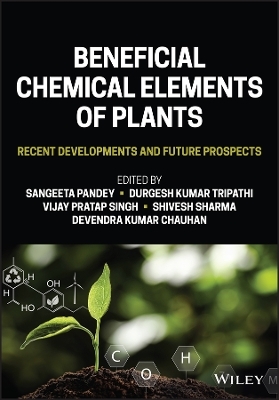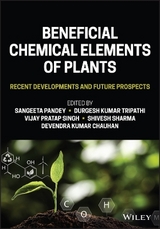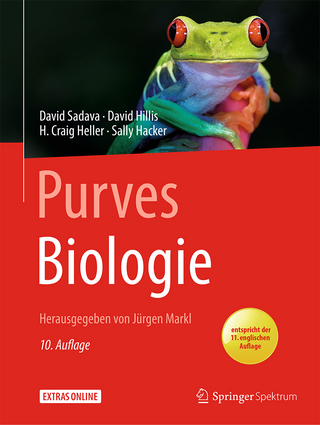Beneficial Chemical Elements of Plants
John Wiley & Sons Inc (Verlag)
978-1-119-68880-8 (ISBN)
BENEFICIAL CHEMICAL ELEMENTS OF PLANTS
Understand beneficial elements and their role in the future of botany and agriculture
Beneficial elements are those which, while not essential to plant life, can provide stimulation and enhance plant growth. Properly harnessed, these elements can bolster plant growth in the face of environmental conditions—including drought, nutrient deficiency, and excessive soil salinity—and biotic stresses like pathogens and animal activity. As climate change and population growth pose increasingly serious challenges to agriculture and essential plant production, it has never been more important to unleash the potential of beneficial elements.
»Beneficial Chemical Elements of Plants« is an essential resource for researchers and industry specialists looking to enhance their understanding of these elements and the range and variety of their enhancements to plant growth.
Written by leading scholars in the field of plant stress tolerance and nutrient enrichment, it discusses not only the rich possibilities of beneficial elements but their mechanisms of action at both biochemical and molecular levels.
It details the precise potential roles played by each major beneficial element and surveys a range of elemental responses to specific environmental conditions and plant stresses.
»Beneficial Chemical Elements of Plants« readers will also find:
- Chapters covering beneficial elements including aluminum, cobalt, sodium, selenium, and silicon
- Discussion of application methods and typical plant responses
- Treatment of beneficial elements in a wider environmental context
- Beneficial element applications to the field of sustainable agriculture
»Beneficial Chemical Elements of Plants« is a fundamental starting point for researchers and students in the fields of plant physiology, crop science, agriculture, and botany, as well as for professionals in the biotechnology and agricultural industries.
Sangeeta Pandey is Assistant Professor at the Amity Institute of Organic Agriculture, Amity University Uttar Pradesh, Noida, India.
Durgesh Kumar Tripathi is Assistant Professor at the Amity Institute of Organic Agriculture, Amity University Uttar Pradesh, Noida, India.
Vijay Pratap Singh is Assistant Professor, CMP Degree Collage, University of Allahabad, Prayagraj, India.
Shivesh Sharma is Professor at the Department of Biotechnology, Motilal Nehru National Institute of Technology, Allahabad, Prayagraj, India.
Devendra Kumar Chauhan is Professor and Head of the Department of Botany at the DD Pant Interdisciplinary Research Laboratory, University of Allahabad, Allahabad, India.
Preface xiii
List of Contributors xv
1 Beneficial Elements in Plant Life Under A Changing Environment 1
Misbah Naz, Muhammad Ammar Raza, Muhammad Adnan Bodlah, Sarah Bouzroud, Muhammad Imran Ghani, Muhammad Riaz, Tariq Shah, Akmal Zubair, Imran Bodlah, and Xiaorong Fan
Introduction 1
Beneficial Element Interaction with Environment 2
Aluminium (Al) in Plants 3
Aluminium (Al) in Soil – Aluminium, a Friend or Foe of Higher Plants in Acidic Soils 4
Cobalt (Co) in Plants 5
Cobalt (Co) in Soil 6
Silicon (Si) 9
Function of Silicon 10
Silicon in Soil 11
Sodium in Plants 12
Sodium in Soil 12
Selenium (Se) 13
Selenium in Environment 13
Physiological Functions of Beneficial Elements Under A Changing Environment 13
5-Beneficial Elements Against Stresses 14
Conclusion 15
References 15
2 Role of Beneficial Elements in Epigenetic Regulation of Plants in Response to Abiotic
Stress Factors 22
Muhittin Kulak and Adnan Aydin
Introduction 22
Beneficial Elements for Crop and Non-Crop Plants 22
Selenium 22
Silicon 23
Aluminium 23
Sodium 23
Cobalt 23
Abiotic Stress Factors 23
Epigenetic Modifications Under Stressful Conditions 24
Studies Regarding the Effect of Beneficial Elements on Epigenetic Changes in the Genome of Plants 28
Selenium 28
Cobalt 28
Sodium 29
Aluminium 29
Silicon 30
Conclusion 30
References 30
3 Beneficial Elements and Status of ROS and RNS in Plants: Current Evidence and Future Prospects 38
Biswajita Pradhan, Rabindra Nayak, Srimanta Patra, Chhandashree Behera, Soumya Ranjan Dash, and Mrutyunjay Jena
Introduction 38
Essential and Beneficial Elements in Plant Physiology: A Pleasant Dilemma 39
Aluminium 40
Cobalt 41
Sodium 42
Selenium 42
Silicon 44
ROS and RNS Production Sites in Plant Cells: Cellular Redox Compartments with Regards to Essential Elements 45
ROS and RNS Production and Their Function in Plants: Connecting Physiology to Stress Physiology 47
Conclusion and Future Perspectives 48
Acknowledgments 49
Conflicts of Interest 49
References 49
4 Biostimulant Effects and Concentration Patterns of Beneficial Elements in Plants 58
Libia I. Trejo- Téllez, Libia F. Gómez- Trejo, and Fernando C. Gómez- Merino
Introduction 58
Aluminium 59
Cerium 69
Cobalt 70
Iodine 72
Lanthanum 73
Selenium 75
Silicon 77
Sodium 79
Titanium 80
Vanadium 82
Conclusions and Perspectives 83
References 84
5 Targeted Effects of Beneficial Elements in Plant Photosynthetic Process 103
Costanza Ceccanti, Ermes Lo Piccolo, Lucia Guidi, and Marco Landi
Introduction 103
Effect of Metal Beneficial Elements 104
Effect of Non-metal Beneficial Elements 114
Conclusion 116
References 116
6 Aluminium Stress in Plants: Consequences and Mitigation Mechanisms 123
Akbar Hossain, Sagar Maitra, Sukamal Sarker, Abdullah Al Mahmud, Zahoor Ahmad, Reza Mohammad Emon, Hindu Vemuri, Md Abdul Malek, M. Ashraful Alam, Md Atikur Rahman, Md Jahangir Alam, Nasrin Jahan, Preetha Bhadra, Debojyoti Moulick, Saikat Saha, Milan Skalicky, and Marian Brestic
Introduction 123
An Overview of Al Toxicity in Plants 124
Effect on Root Growth 124
Oxidative Stress 126
Nutrient Imbalances 127
Mechanisms for Al Stress Tolerance in Plants 127
Phenotyping for Al-toxicity Tolerance in Plants 128
Physiological Mechanisms of Al Tolerance in Plants 128
Morpho-physiological Mechanisms 129
Biochemical Mechanisms 130
Cellular Mechanisms 130
Phytohormones-based Aluminium Stress Tolerance in Plants 133
Antioxidants-based Aluminium Stress Tolerance in Plants 134
Potential Transgenic Approach for Aluminium Toxicity Improvement 134
Genes Responsive Under Aluminium Toxicity 135
Gene Family Variation 136
Interference in the Resistance Mechanism 136
Expression and Regulation of Gene Families 136
Genetic Engineering 138
Pyramiding of Genes 138
Phytoremediation of Al Stress in Plants 139
Microorganism-mediated Aluminium Stress Tolerance in Plants 142
Agronomic Management for Mitigating Aluminium Stress in Plants 143
Role of Inorganic Amendments for Mitigating Al Toxicity in Plants 144
Calcium (Ca) as a Mitigator of Al Toxicity 144
Phosphorus (P) as a Mitigator of Al Toxicity 146
Magnesium (Mg) as a Mitigator of Al Toxicity 146
Boron (B) as a Mitigator of Al Toxicity 147
Sulphur (S) as a Mitigator of Al Toxicity 147
Silicon (Si) as a Mitigator of Al Toxicity 147
Role of Organic Amendments for Mitigating Al Toxicity in Plants 147
Biochar as a Mitigator of Al Toxicity 147
Compost or Organic Matter as a Mitigator of Al Toxicity 148
Conclusion 148
Conflict of Interest 149
References 149
7 Mechanisms of Cobalt Uptake, Transport, and Beneficial Aspects in Plants 169
Zaid Ulhassan, Aamir Mehmood Shah, Ali Raza Khan, Wardah Azhar, Yasir Hamid, and Weijun Zhou
Introduction 169
Mechanisms of Cobalt Uptake and Transport in Plants 170
Beneficial Aspects of Cobalt in Plants 172
Growth and Yield 172
Nitrogen Fixation and Nodule Formation 173
Alterations in Nutrient Status 173
Alterations in Physiological and Biochemical Constituents 174
Antioxidant Enzyme Activities and Synthesis of Hormones 175
Protective Roles of Cobalt Against Abiotic Stresses 175
Conclusions and Future Prospects 176
Acknowledgments 177
References 177
8 Cobalt in Plant Life: Responses and Deficiency Symptoms 182
Xiu Hu, Xiangying Wei, Jie Ling, and Jianjun Chen
Introduction 182
Cobalt in Lower Plants 184
Bryophytes 184
Algae 185
Cobalt in Higher Plants 186
Root Absorption of Cobalt 186
Cobalt Transport in Plants 187
Cobalt Effects on Plant Growth 188
Cobalt is Essential for N 2 Fixation in Nodulated Legumes 188
Cobalt Enhances Growth of Non-Leguminous Crops 190
Possible Mechanisms 190
Other Beneficial Effects on Plants 192
Cobalt Deficiency in Plants 192
Cobalt Toxicity in Plants 194
Conclusions and Future Perspectives 196
References 197
9 Silicon Uptake, Transport, and Accumulation in Plants 205
Shivani Sharma, Muntazir Mushtaq, Sreeja Sudhakaran, Vandana Thakral, Gaurav Raturi, Ruchi Bansal, Virender Kumar, Sanskriti Vats, S. M. Shivaraj, and Rupesh Deshmukh
Introduction 205
Molecular Mechanism Involved in Silicon Uptake 206
Seminal Studies Defining Uptake of Silicon in Different Plant Species 206
Silicon Influx Transporter 207
Silicon Efflux Transporter 209
Cordial Activity of Silicon Influx and Efflux Transporter 211
Other Homologs of Silicon Influx and Efflux Transporter 213
Silicon Transporters yet to be Discovered 213
Silicon Deposition in Different Tissues 214
Silicon Deposition in Roots 214
Silicon Deposition in Shoot 214
Silicon Deposition in Leaves 216
Phytoliths: Biochemical Composition and Deposition Patterns 217
Silicon Deposition and the Phytolith Formation 218
Role of Phytoliths in the Silicon Biogeochemical Cycle 220
References 222
10 Silicon in Soil, Plants, and Environment 227
Mujahid Ali, Muhammad Zia Ur Rehman, Asad Jamil, Muhammad Ashar Ayub,
and Muhammad Tahir Shehzad
Introduction 227
Sources of Silicon in Soil, Plants and Environment 228
Natural Sources 228
Artificial/Synthetic Sources 228
Uses of Silicon 229
Industrial Use 229
Application in Agro-ecosystems 229
Role of Silicon in Plant Nutrition-Growth Responses 230
Nutrient Acquisition 230
Plant Growth Promotion 230
Gas Exchange Attributes Modulation 230
Plant Water Balance 230
Antioxidant Enzymes Activities 231
Uptake and Translocation Mechanisms of Silicon 231
Role of Silicon in Agriculture 232
Role of Silicon in Abiotic Stress Management 232
Heavy Metals 232
Salinity 232
Water Stress 234
Temperature Stress 234
Role of Silicon in Biotic Stress Management 237
Pest Attack 237
Role of Silicon in Disease Management 237
Silicon-Mediated Endogenous Modifications in Plants 238
C. Mechanism of Silicon-Mediated Abiotic Stress Management 238
D. Mechanism of Silicon-Mediated Biotic Stress Management 241
Source of Silicon for Agricultural Application 241
Recommendations for Exogenous Silicon Applications 242
Conclusion and Future Perspectives 242
References 242
11 Silicon- Mediated Alleviation of Heavy Metal Stress in Plants 256
Sana Rana, Muhammad Zia ur Rehman, Muhammad Umair, Muhammad Ashar Ayub, and Muhammad Arif
Introduction 256
Heavy Metal (HM) Sources in Agro-ecosystem 257
The Response of Plants Towards HM Stress 257
Sources of Silicon in Soil 258
Role of Silicon in HM Stress Management 258
Silicon Role in Plant Nutrition 259
Silicon-Mediated HM Management Mechanisms 259
Reduction of HM Uptake 259
Modification of Rhizosphere Chemistry/Making Si Complexes with Metals 260
Stimulation of Antioxidants 260
Help in Compartmentation of HM Inside Plants 260
Gene Expression Modification 261
Structural and Physiological Modification 261
Exogenous Application of Silicon to Manage HM Toxicity 261
Silicon Fertilizer 262
Biogenic Si Sources (Organic Amendments Enriched in Si) 262
Silicon Nanoparticles 265
Summary 266
References 266
12 How Does Sodium Content in Growing Media Affect the Chemical Content of Medicinal and Aromatic Plants? Two Sides of the Coin 277
Ahmet Metin Kumlay, Muhittin Kulak, Mehmet Zeki Kocak, Ferdi Celikcan, and Mehmet Hakki Alma
Introduction 277
What Kinds of Functions Have Been Attributed to Sodium for Proper Metabolism of the Plant? 278
What Kind of Perturbations Might Emerge in Case of Deficiency or Excessive Accumulation of Sodium in Growing Media and in Turn, in Plants? 279
What Are the Major Mechanisms Associated with the Damage Caused by High Salinity? 279
Compartmentalization of Sodium Through Plant Parts 280
Why Is the Sodium/Potassium Ratio Important for Plant Metabolism? 280
How Do Priming or Osmo-Conditioning Seeds Using NaCl Solutions Imprint the Sequential Growth Performance or Stage of the Plants? An Approach Regarding Imprint Memory with Low Concentration versus Higher Subsequent Concentration of NaCl 281
What Are Medicinal and Aromatic Plants and Metabolites of Those Plants? How Do Those Metabolites Respond to Higher Content of Na in Media Regarding Total Content and Their Specific Compounds? 281
The Growth, Development, and Yield are Adversely Affected Under High Sodium Concentration of Growing Media, but What Can We Say for Contents of Total Metabolites or Specific Compounds? 282
Alkaloids 282
Terpenoids 283
Phenolics 286
What Kinds of Explanations Have Been Postulated for Changes Concerned with Defence-Related Metabolites in Those Plants Exposed to Higher Levels of Sodium in Growing Media? 297
Do Lower or Higher Concentration of the Sodium Favour Metabolites? 297
Two Sides of the Coin: Is a Third Probability Possible for Plant Production Versus Secondary Metabolite Production? 298
Conclusion 298
References 299
13 Sodium and Abiotic Stress Tolerance in Plants 307
Misbah Naz, Muhammad Imran Ghani, Muhammad Jawaad Atif, Muhammad Ammar Raza, Sarah Bouzroud, Muhammad Rahil Afzal, Muhammad Riaz, Maratab Ali, Muhammad Tariq, and Xiaorong Fan
Introduction 307
Relationship Between Salinity and Plant 309
Salinity and the Ideal Sustainable Agricultural System 310
Relationship Between Salinity and Sodicity and Soil 311
Salt Stress Effects on Plants 311
Management Strategies to Mitigate Salt Injury 312
Salt Sensitivity 313
Genetic Engineering and Salt-Tolerant Transgenic Plants 316
Role of Sodium in Plants 317
Osmotic Tolerance 318
Proteomics Study in Plant Responses and Tolerance to Salt Stress 318
Ion Uptake/Homeostasis 319
Role of Phytohormones for Abiotic Stress Tolerance 320
Interaction Between Na + and K + in Plants
321
Interactions Between Na + and Mg 2+ in Plants 322
Interactions Between Na + and Ca 2+ in Plants 322
Conclusion 323
References 323
14 Selenium Species in Plant Life: Uptake, Transport, Metabolism, and Biochemistry 331
Zaid Ulhassan, Ali Raza Khan, Wardah Azhar, Yasir Hamid, Durgesh Kumar Tripathi, and Weijun Zhou
Selenium Speciation in the Soil-Plant System 331
Accumulation and Uptake of Selenium Species by Plants 331
Transport Mechanisms of Selenium Species within Plants 333
Selenium Metabolism in Plants 333
Step 1: Conversion of Selenate into Selenite and Selenide 333
Step 2: Selenide to Selenocysteine (SeCys) Transformation 334
Step 3: Transformation of Selenocysteine (SeCys) into Elemental Se 0 and Alanine (Ala) 335
Step 4: Metabolic Pathways of Methyl Selenomethionine (MeSeMet) 335
Biochemistry of Selenium 335
Is Selenium an Essential Trace Element for Plants? 335
Conversion of Inorganic to Organic Selenium Forms (The First Step of the Se-Assimilation Pathway) 336
Adaptive Mechanisms by Plants to Evade Selenium Toxicity Participation of Se-Amino Acids 338
Volatilization of Selenium Organic Compounds 338
Involvement of Selenocysteine Lyase 339
Sequestration of Selenium Organic Compounds 339
Antioxidant Defense Mechanisms 340
Involvement of Phytohormones or Signalling Molecules 340
General Conclusions and Future Prospects 341
Acknowledgments 342
References 342
15 Lanthanides as Beneficial Elements for Plants 349
Fernando C. Gómez- Merino, Libia F. Gómez- Trejo, Rubén Ruvalcaba- Ramírez, and Libia I. Trejo- Téllez
Introduction 349
Lanthanides in Biological Systems 353
Lanthanides in Plants 355
Beneficial Effects of Lanthanides in Plants 356
Conclusions and Future Research Needs 360
References 360
Index 370
| Erscheinungsdatum | 09.09.2023 |
|---|---|
| Verlagsort | New York |
| Sprache | englisch |
| Maße | 170 x 244 mm |
| Gewicht | 1252 g |
| Einbandart | gebunden |
| Themenwelt | Naturwissenschaften ► Biologie |
| Weitere Fachgebiete ► Land- / Forstwirtschaft / Fischerei | |
| ISBN-10 | 1-119-68880-9 / 1119688809 |
| ISBN-13 | 978-1-119-68880-8 / 9781119688808 |
| Zustand | Neuware |
| Informationen gemäß Produktsicherheitsverordnung (GPSR) | |
| Haben Sie eine Frage zum Produkt? |
aus dem Bereich




